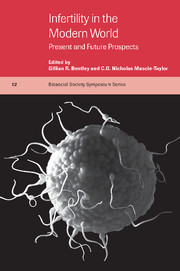1 - Introduction
Published online by Cambridge University Press: 13 January 2010
Summary
This book illustrates the ways in which human biology and culture can affect fertility and outlines some of the modern technologies that, at least in the Western world, can alleviate the physiological problems associated with infertility. It results from a Biosocial Society Symposium held in Cambridge, U.K. in May 1998. It is organized into three sections, each containing two chapters. The first section (with chapters by co-authors S. Fishel, K. Dowell and S. Thornton as well as A. H. Bittles and P. L. Matson) covers the more technical and clinical aspects of infertility that are primarily relevant to industrialized nations with access to modern technologies and the research capabilities to address (and often ameliorate) specific issues of infertility. The second section (with chapters by G. R. Bentley, and J. C. and P. Caldwell) deals with environmental aspects of infertility, including the consequences of industrial pollution for human fertility, and the effects of sexually transmitted diseases (STDs) in the area of sub-Saharan Africa. Finally, the third section (with chapters by F. McAllister and L. Clarke, as well as C. J. Patterson and L. V. Friel) addresses the social aspects of infertility and the importance of behaviour in determining infertility.
It is impossible to compute the incidence of human infertility as a raw statistic or to reduce it to a simple figure. Infertility varies from country to country and from cohort to cohort, depending on the sample, the population surveyed, whether males are included together with females, and whether these figures include ‘social infertility’ (such as childlessness by choice) as opposed to physiological infertility.
- Type
- Chapter
- Information
- Infertility in the Modern WorldPresent and Future Prospects, pp. 1 - 14Publisher: Cambridge University PressPrint publication year: 2000



